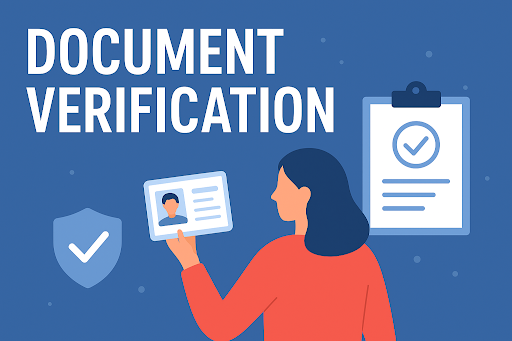Any digital communication in the present day starts with a test of faith. It is required that the service provider authenticates the identity of the user whether they are opening a bank account, trading cryptocurrency, applying to an online loan or registering on a government portal. The verification of documents is what enables this confirmation to take place. It is now part of digital identity verification, and a mandatory requirement in a risk-dealing, finance-dealing, or sensitive information industry.
What Does Document Verification entail?
Document verification is a concept that is used to check official documents including passports, identity cards, residency documents, and other personal or company documents. This is aimed at identifying whether the document is authentic or not, and whether the data contained in it is true or not. It was traditionally manual and holograms or signature security features were checked by eye by employees. Nevertheless, the current system of verification depends on automated technologies, which have become more efficient in terms of manipulation, duplication, or forgery than the human eye.
The relationship between the document verification and KYC Documents
In most industries, the term KYC documents is used in connection with identity records applied in terms of verification. KYC (or Know Your Customer) is a regulatory requirement that obliges organizations to gather and verify information of individuals before providing them with access to the services. These are not those papers that are merely gathered on paper. These are verified in order to verify identity, assess risk, and make sure that the customer has not participated in money laundering or any other criminal activity. KYC document verification is thus a very important measure in customer onboarding and fraud prevention over the long term.
The reason why Compliance relies on the verification of documents
Financial institutions, cryptocurrency exchanges, telecommunication companies, real estate agents, and, currently, even web-based marketplaces have been subject to intense requirements by regulators all around the globe. Such companies need to perform checks on documents to meet the Anti-Money laundering models and customer due diligence regulations. They are liable to legal consequences, mistrust and in worst case situations, shutdown as a result of improper verification. That is why document verification cannot be considered a best practice only but rather a fundamental compliance aspect that safeguards the business and the customer.
The Uses of Technology in Contemporary Verification
Artificial intelligence has made it fast and scalable, what was previously a manual and time-consuming process. A system based on AI document verification examines patterns to detect inconsistencies in fonts, layout, metadata, or signature embedded in the document. Optical character recognition breaks down text that has been scanned whereas biometric authentication confirms that the individual signing the document is the legitimate owner. These systems can support thousands of document formats of various regions and this is vital to platforms that serve users internationally.
Application of Document Checking in Various industries
One of the first to implement the use of digital document checks as a security measure against fraud, counterfeited loan applications, and identity theft, was the financial sector. Fintechs were the next to implement verification features coming to their mobile applications and digital wallets. Document verification is applied by e-commerce sites during the registration of sellers or highly valued transactions. It is used by government departments when giving digital identities or licences or welfare benefits. Even online education platforms and gig platforms are now verifying documents to prevent bots, impersonators, and other parties that are not legitimate users.
How Document Verification Can Prevent Fraud
Solenitude Fraud has not been restricted to stolen credit cards. Crooks have now tried to establish fake identities through synthesis of real and false data so as to evade loosely implemented verification procedures. Document verification interferes with this trick by insisting on consistency in various aspects like personal information, photos and concealed security measures. Used in conjunction with biometric analysis and user conduct tracking, document checking is an effective fraud prevention tool that prevents malicious actors prior to their admittance to a platform.
The Difficulty of Securing and Simplifying
Users require services on demand and even a single onboarding moment must be fast or problematic. This places businesses in a tight position of having to stamp documents within a short period and still do so without affecting the accuracy. There are still organizations that are still using the manual method and hence a long queue. Some people embrace complete automated verification systems but have problems with false rejections in case of bad lighting or images. The best solution is a combination of automation and smart review, which means that in standard cases, the system will be capable of processing them immediately and forward unclear files to humans to evaluate them.
Future of Document Verification
The second document verification process will have built-in blockchain technology of tamper-free identity records and decentralized identity systems where users can manage the sharing of their data. AI will develop further on detecting digital forgery, and biometric verification will become more mature, as facial recognition can correctly validate a document with an accuracy sufficient to work as a standalone validation of a document. Document verification will cease to be viewed as an entry level requirement but as a continuous practice of monitoring and trust management especially as more industries change to remote service delivery.
Conclusion
The verification of a document has become an unavoidable level of security in the digital environment. It secures businesses against fraud, aids companies to achieve compliance standards, and it provides customers with the assurance that their identities are being responsibly managed. Through authentication of KYC documents and the inclusion of smart verification services, organizations will be able to develop safer platforms and provide easy onboarding experiences. Trust cannot be seen, but verification of documents is what enables it to make it measurable and enforceable in any digital interaction.

